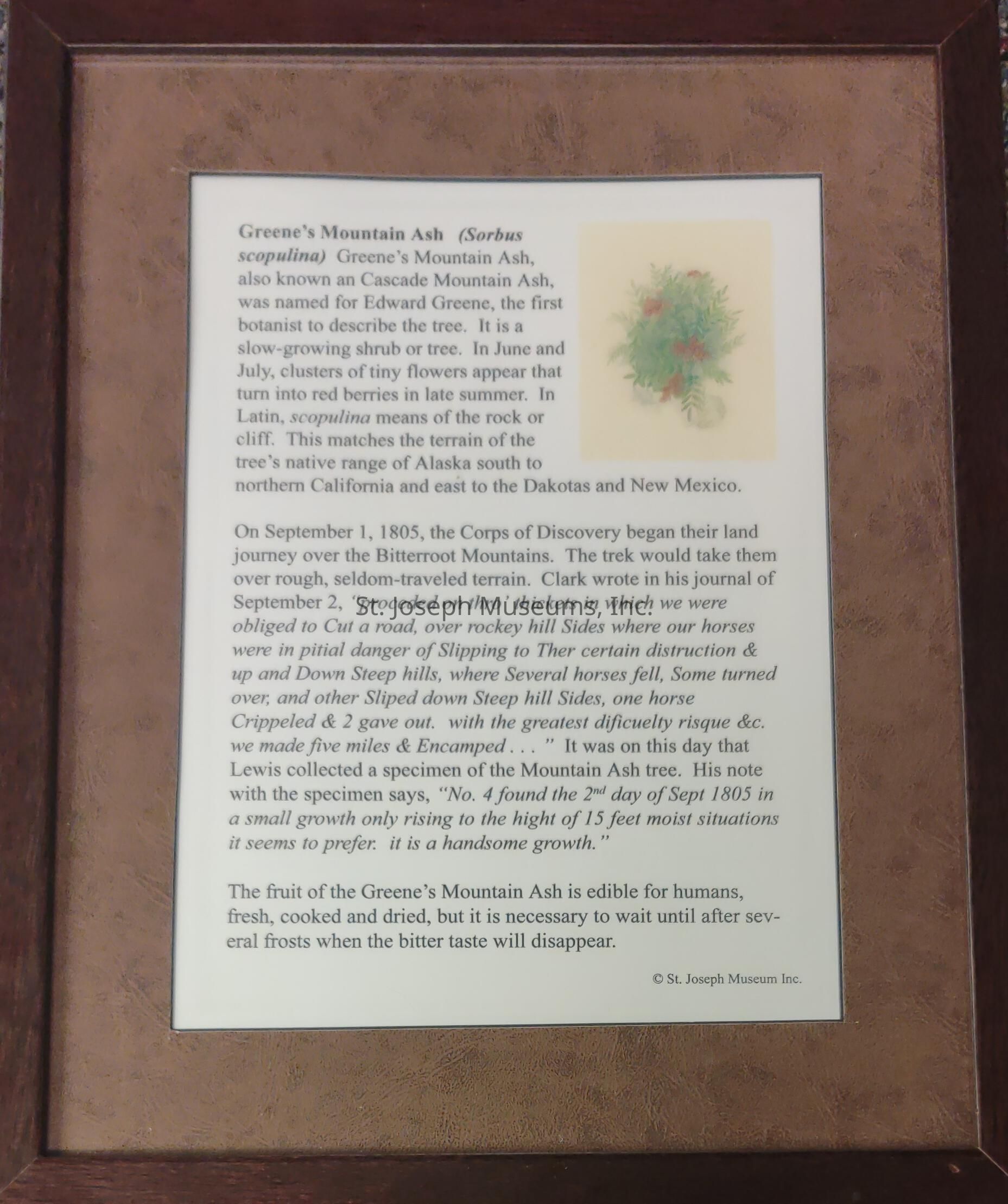Name/Title
Greene's Mountain Ash (Sorbus scopulinaEntry/Object ID
2021.1.40 BScope and Content
Greene's Mountain Ash (Sorbus scopulina) plant description, framed.
Greene's Mountain Ash, also known as Cascade Mountain Ash, was named for Edward Greene, the first botanist to describe the tree. It is a slow-growing shrub or tree. In June and July, clusters of tiny flowers appear that turn into red berries in late summer. In Latin, scopulina means of the rock or cliff. This matches the terrain of the tree's native range of Alaska south to northern California and east to the Dakotas and New Mexico.
On September 1, 1805, the Corps of Discovery began their land journey over the Bitterroot Mountains. The trek would take them over rough, seldom-traveled terrain. Clark wrote in his journal of September 2, "proceded on thro' thickets in which we were obliged to Cut a road, over rockey hill Sides where our horses were in pitial danger of Slipping to Ther certain distruction & up and Down Steep hills, where Several horses fell, Some turned over, and other Sliped down Steep hill Sides, one horse Crippeled & 2 gave out. with the greatest dificuelty risque &c. we made files miles & Encamped..." It was on this day that Lewis collected a specimen of the Mountain Ash tree. His note with the specimen says, "No.4 found the 2nd day of Sept 1805 in a small growth only rising to the hight of 15 feet moist situations it seems to prefer. it is a handsome growth."
The fruit of the Greene's Mountain Ash is edible for humans, fresh, cooked and dried, but it is necessary to wait until after several frosts when the bitter taste will disappear.Context
Originally designed by the St. Joseph Museum in the fall of 2004. Titled "Botanical Wonders of the Uncharted West. The Recorded Flora of the Lewis & Clark Expedition."Collection
Lewis and ClarkLexicon
LOC Thesaurus for Graphic Materials
Botanical drawings, Expeditions & surveysArchive Items Details
Title
Greene's Mountain Ash (Sorbus scopulina)Creator
Mary L. FletcherDate(s) of Creation
2004Subjects
Plants, Watercolor paintingsParts
Count
2Parts
Watercolor of plant and descriptive label, both framed.Condition
Overall Condition
Very GoodProvenance
Notes
"Botanical Wonders of the Uncharted West" visually depicts how well Lewis followed Jefferson's instructions. In recognition of this achievement, The S. Joseph Museums, Inc. commissioned accomplished artist Mary Fletcher to create fifty (50) selected paintings of flora documented by the Corps during their Journey. These framed watercolor originals are accompanied by similarly framed labels, generated by former Head of Research Jackie Lewin, which describe the corresponding plants with appropriate quotations from the Journals. This collection makes available for study and appreciation plants that were new to Lewis and Clark, but which Native Peoples already recognized as valuable sources of food, medicine, and tools. Some of these still remain a mystery to many, but all will enjoy their beauty, their diverse uses, and their accomplished renderings.
